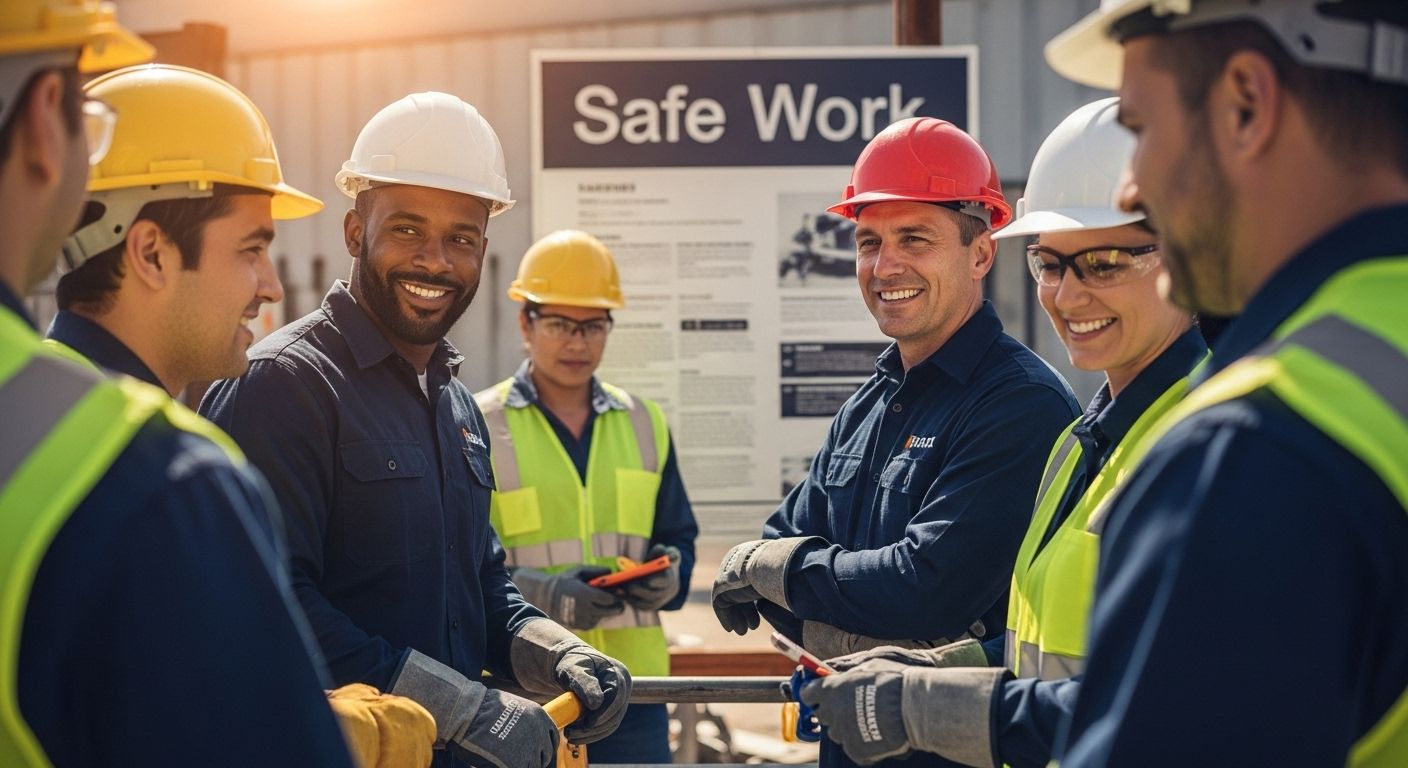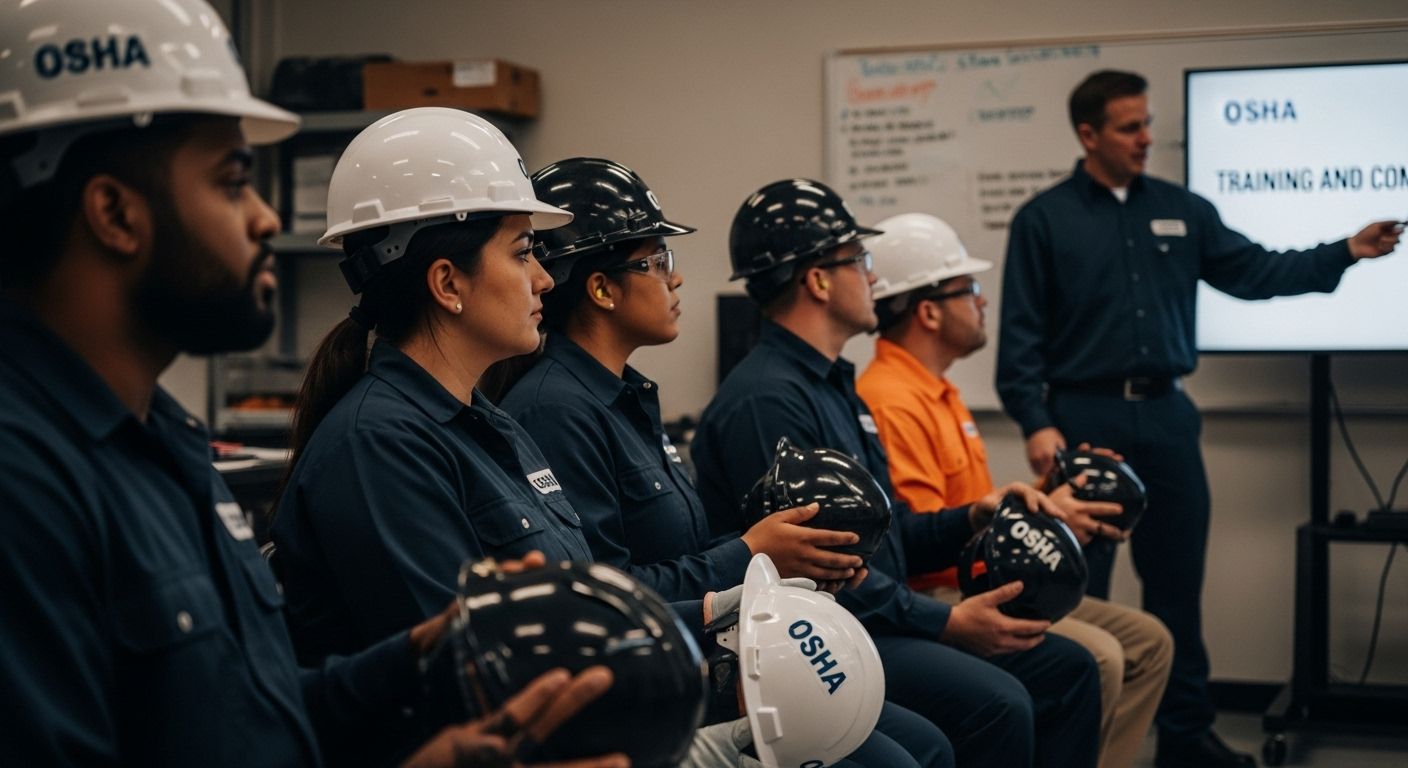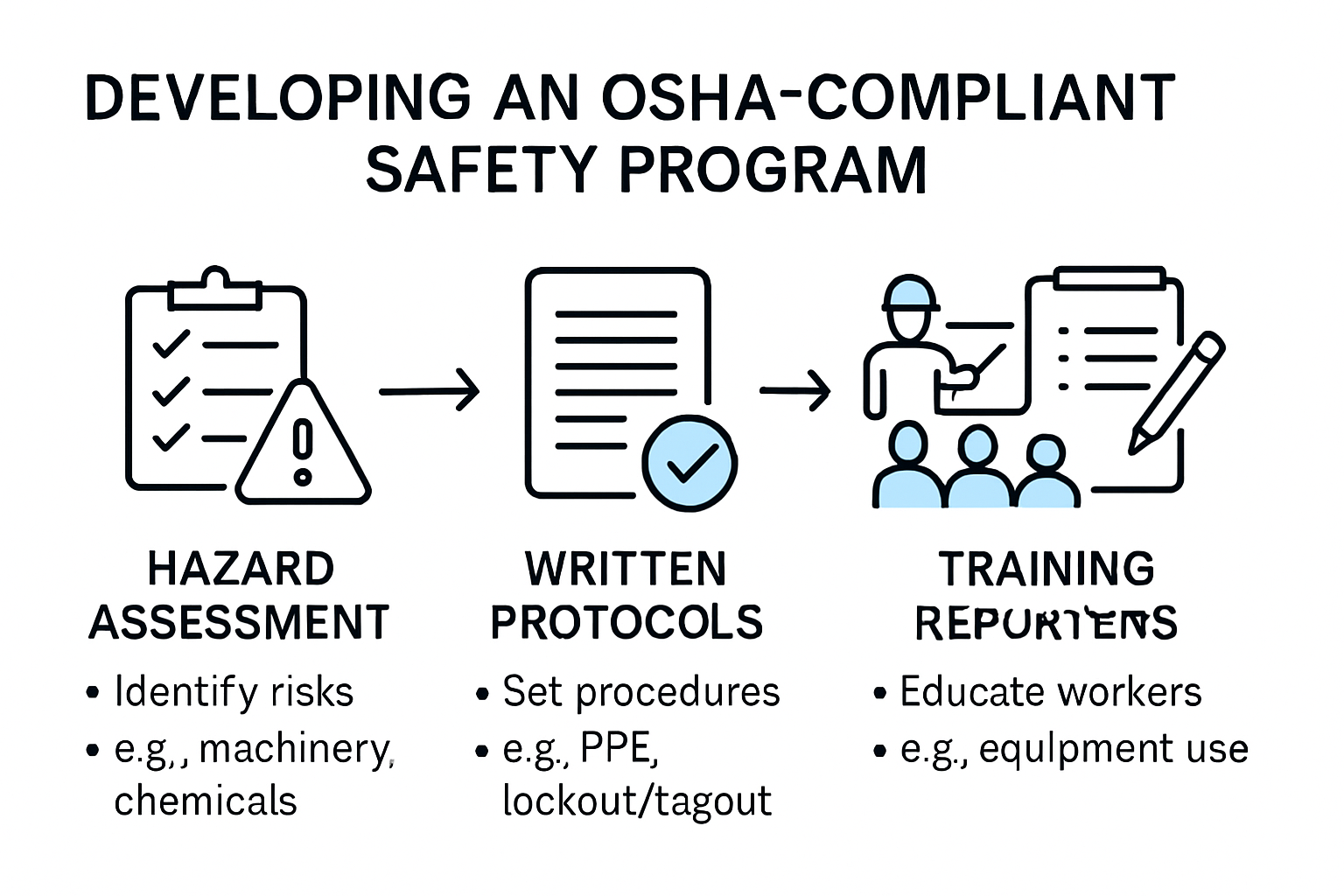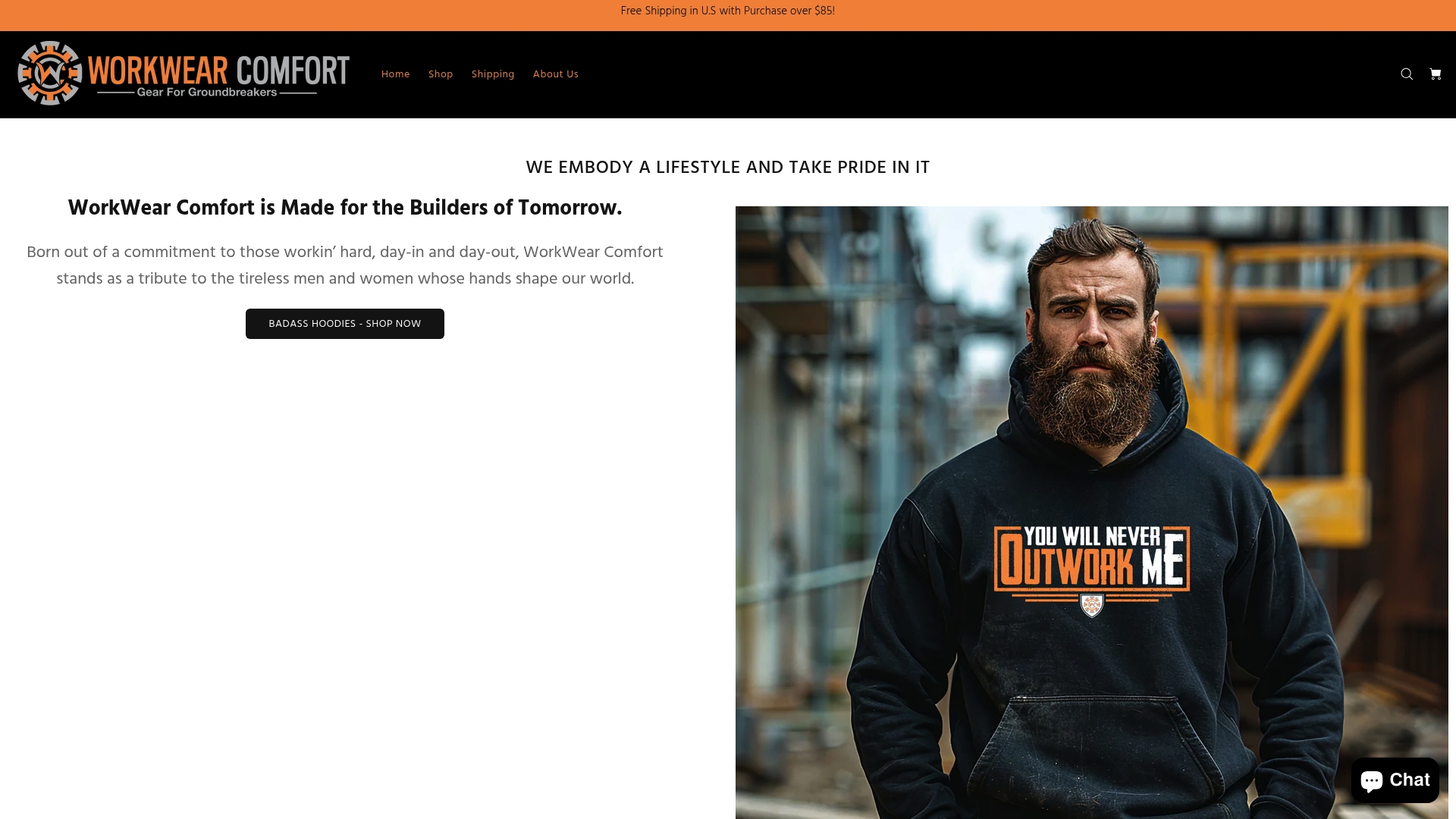
Workplace safety can feel like just another box to check for blue-collar workers across America. But did you know that OSHA estimates its regulations have saved over 600,000 lives since 1970? Most people think safety rules are just paperwork and red tape. The real surprise is how these standards protect your rights on the job and give workers the power to speak up, demand real protection, and count on coming home safe every single day.
Table of Contents
- What Osha Means For Blue-Collar Workers
- Key Osha Safety Standards In Construction And Trades
- Workwear And Ppe: Meeting Osha Requirements
- How To Stay Osha Compliant On The Job
Quick Summary
| Takeaway | Explanation |
|---|---|
| OSHA protects blue-collar workers’ rights | Under OSHA, workers are entitled to a safe environment free from serious hazards and have access to safety training. |
| Safety standards go beyond mere compliance | A culture of safety emphasizes proactive strategies such as detailed reporting and regular inspections to prevent accidents. |
| Specific guidelines exist for high-risk jobs | OSHA provides tailored safety protocols for construction and trades, focusing on key areas like fall protection and electrical safety. |
| PPE is a must for workplace safety | Employers must provide appropriate personal protective equipment after assessing the specific hazards present in the workplace. |
| Continuous training and improvement ensure safety | Ongoing training and regular safety audits are essential for maintaining compliance and fostering a safe working environment. |
What OSHA Means for Blue-Collar Workers
Blue-collar workers are the backbone of American industry, and OSHA serves as their critical shield against workplace dangers. Understanding OSHA’s role means recognizing how this federal agency protects workers who face daily risks in construction, manufacturing, trades, and other physically demanding professions.
Protecting Workers’ Fundamental Rights
OSHA fundamentally transforms workplace safety from a suggestion to a legal requirement. Workplace safety standards aren’t just bureaucratic paperwork—they’re a lifeline for workers facing potential hazards every single day. According to the U.S. Department of Labor, blue-collar workers have specific rights under OSHA regulations, including:
- Right to a Safe Environment: Employers must provide workspaces free from recognized serious hazards
- Access to Training: Workers can receive free safety training in their primary language
- Protection from Retaliation: Employees can report unsafe conditions without fear of losing their job
These protections are especially crucial in industries where physical risks are inherent. Construction sites, manufacturing floors, and industrial settings present unique challenges that demand comprehensive safety protocols.
Beyond Regulations: A Culture of Safety
OSHA’s impact extends far deeper than simple rule enforcement. The agency actively works to create a proactive safety culture where prevention becomes as important as productivity. By requiring detailed incident reporting, mandatory training, and regular workplace inspections, OSHA transforms workplace safety from a reactive process to a strategic approach.
For blue-collar workers, this means more than avoiding accidents—it means developing skills, awareness, and a comprehensive understanding of workplace risks. Whether you’re a welder, electrician, or construction worker, OSHA’s guidelines provide a systematic approach to identifying and mitigating potential dangers before they become life-threatening incidents.
Real-World Protection for Skilled Professionals
Practical implementation of OSHA standards directly translates to saved lives and reduced workplace injuries. Tradespeople benefit from specific guidelines that address unique risks in their profession. Electricians receive detailed protocols for handling electrical systems, construction workers get comprehensive fall protection standards, and manufacturing employees obtain clear guidelines for machine operation and personal protective equipment.
Beyond the technical aspects, OSHA represents a fundamental commitment to worker dignity. It acknowledges that every worker deserves a safe environment, regardless of their job’s physical demands. For blue-collar professionals who often work in challenging and potentially dangerous conditions, this commitment is not just a legal requirement—it’s a professional respect.
Discover our guide to professional workwear that meets safety standards and helps you stay protected on the job. Understanding OSHA isn’t just about following rules—it’s about creating a workplace where every worker can return home safely at the end of the day.
Key OSHA Safety Standards in Construction and Trades
Construction and trades represent some of the most high-risk work environments in America, which is why OSHA has developed comprehensive safety standards designed to protect workers from potential hazards. Understanding these critical regulations can mean the difference between a safe workday and a life-altering accident.
Fall Protection and Height Safety
Fall protection stands as one of the most crucial safety standards in construction. OSHA’s Construction Industry Compliance page highlights fall protection as the most frequently cited violation, underscoring its critical importance. According to the U.S. Department of Labor, workers must be protected when working at heights of 6 feet or more in construction zones.
Key fall protection requirements include:
- Guardrail systems
- Safety net systems
- Personal fall arrest systems
- Comprehensive training on fall hazard recognition
Employers must provide appropriate fall protection equipment and ensure workers are thoroughly trained in its proper use. This means not just supplying a harness, but teaching workers how to inspect, wear, and maintain their safety gear.
Electrical Safety Standards
Electrical hazards pose significant risks in construction and trades. The potential for electric shock, electrocution, and fire makes electrical safety a top priority. OSHA mandates specific protocols to minimize these dangers, including:
- Proper grounding of electrical equipment
- Use of ground fault circuit interrupters (GFCIs)
- Maintaining safe distances from electrical sources
- Regular inspection and maintenance of electrical tools and equipment
Electricians and workers handling electrical systems must undergo specialized training to recognize and mitigate potential electrical risks. This includes understanding proper lockout/tagout procedures, identifying potential hazards, and using appropriate personal protective equipment.
Hazard Communication and Personal Protection
Comprehensive hazard communication is another critical OSHA standard. OSHA’s Compliance Assistance Quick Start emphasizes the importance of informing workers about potential chemical and physical hazards in their workplace. This involves:
- Maintaining detailed safety data sheets
- Proper labeling of hazardous materials
- Providing workers with appropriate personal protective equipment (PPE)
- Comprehensive training on hazard recognition and prevention
Tradespeople must be equipped with more than just tools—they need knowledge and protection. Check out our guide to professional workwear that meets safety standards to ensure you’re properly protected on the job.
These OSHA standards are not mere suggestions—they are lifelines that protect workers from potential injuries and fatalities. By understanding and implementing these critical safety protocols, construction and trades professionals can create safer work environments and protect themselves and their colleagues from unnecessary risks.
Here is a summary table outlining the main types of OSHA safety standards mentioned for construction and trades professionals, along with their key requirements. This helps clarify which safety measures apply to different workplace hazards.
| Safety Standard | Key Requirements |
|---|---|
| Fall Protection and Height Safety | Guardrails, safety nets, personal fall arrest systems, comprehensive training, equipment provision |
| Electrical Safety Standards | Proper grounding, GFCIs, safe distances, tool inspection/maintenance, specialized training, lockout/tagout |
| Hazard Communication and Personal Protection | Safety data sheets, hazardous material labeling, PPE provision, comprehensive hazard training |
Workwear and PPE: Meeting OSHA Requirements
Workwear and personal protective equipment (PPE) are not just fashion statements in blue-collar industries—they are critical safety barriers that protect workers from potential workplace hazards. OSHA has established comprehensive standards that transform workwear from optional clothing to mandatory safety equipment.
Understanding PPE Requirements
OSHA’s Personal Protective Equipment standards establish clear guidelines for protecting workers across various industries. According to OSHA Standard 1910.132, employers must conduct thorough hazard assessments and provide appropriate protective equipment that addresses specific workplace risks.
Key PPE requirements include:
- Comprehensive hazard assessment of workplace environments
- Selection of appropriate protective equipment for specific risks
- Proper fitting and maintenance of safety gear
- Regular training on correct usage and limitations
This means workwear isn’t just about looking professional—it’s about creating a defensive layer between workers and potential workplace dangers. From flame-resistant materials for welders to high-visibility jackets for construction workers, each piece of clothing serves a critical protective function.
Material Science and Safety Performance
Modern workwear goes far beyond basic cotton shirts and standard jeans. Advanced textile technologies have revolutionized protective clothing, creating materials that offer multiple layers of protection. Flame-resistant fabrics, moisture-wicking materials, and integrated cooling technologies transform workwear from simple clothing into sophisticated safety systems.
For electricians, welders, and other trades professionals, specialized workwear can mean the difference between minor discomfort and life-threatening injury. Clothing with integrated arc flash protection, chemical resistance, and thermal insulation represents the cutting edge of workplace safety technology.
Training and Compliance
Providing PPE is only half the battle—workers must understand how to use and maintain their protective equipment correctly. OSHA mandates comprehensive training programs that teach workers not just how to wear their gear, but how to inspect, maintain, and recognize when equipment needs replacement.
Explore our guide to professional workwear that meets safety standards and understand how the right clothing can be your first line of defense on the job. From understanding material properties to recognizing potential workplace hazards, proper PPE education is crucial for maintaining a safe work environment.

Ultimately, workwear and PPE represent more than a regulatory requirement—they embody a commitment to worker safety. By investing in high-quality, purpose-designed protective equipment, employers demonstrate that their workers’ health and well-being are paramount. For blue-collar professionals, this means going to work knowing you’re equipped with the best possible protection against workplace risks.
How to Stay OSHA Compliant on the Job
Staying OSHA compliant isn’t just about avoiding fines—it’s about creating a safe, productive workplace that protects workers and employers alike. Understanding and implementing OSHA standards requires a proactive approach that goes beyond simple rule-following.
Developing a Comprehensive Safety Program
OSHA’s Compliance Assistance Quick Start emphasizes the importance of creating a robust safety management system. According to the Department of Labor’s Employment Law Guide, employers must establish a systematic approach to workplace safety that includes:
- Conducting regular workplace hazard assessments
- Creating written safety protocols
- Implementing ongoing employee training programs
- Maintaining detailed incident reporting and investigation processes

A comprehensive safety program goes beyond mere documentation. It requires a cultural commitment to workplace safety that involves every single employee, from management to entry-level workers. This means creating an environment where safety is not just a requirement, but a shared value.
The following table details key employer responsibilities for developing a comprehensive safety program under OSHA compliance, helping readers understand the systematic approach required.
| Employer Responsibility | Description |
|---|---|
| Hazard Assessments | Regularly identify and evaluate workplace hazards |
| Written Safety Protocols | Develop and maintain clear, documented safety procedures |
| Ongoing Employee Training | Implement continuous training programs relevant to roles and workplace risks |
| Incident Reporting and Investigation | Maintain detailed records of incidents and conduct thorough investigations |
| Cultural Commitment | Foster an environment where safety is a shared value among all employees |
Training and Documentation
Knowledge is the most powerful safety tool. OSHA mandates specific training requirements that vary by industry and job role. Effective compliance means:
- Providing role-specific safety training
- Maintaining up-to-date training records
- Conducting regular safety refresher courses
- Ensuring all training materials are accessible and understandable
Training should be more than a checkbox exercise. It needs to be interactive, engaging, and tailored to the specific risks of your workplace. This means using real-world examples, hands-on demonstrations, and ensuring that workers truly understand the potential consequences of safety violations.
Continuous Improvement and Proactive Monitoring
OSHA’s guidance documents highlight the importance of continuous safety improvement. Compliance is an ongoing process that requires:
- Regular internal safety audits
- Prompt investigation of near-misses and incidents
- Staying updated on the latest OSHA standards and industry best practices
- Encouraging open communication about safety concerns
Check out our professional workwear guide to understand how proper equipment can be a crucial part of your compliance strategy. The right workwear is more than just clothing—it’s a critical component of workplace safety.
Ultimately, OSHA compliance is about creating a culture of safety that protects workers, reduces accidents, and creates a more productive workplace. It’s not about following rules—it’s about keeping people safe. By taking a proactive, comprehensive approach to workplace safety, employers can create environments where workers feel protected, valued, and empowered to do their best work.
Frequently Asked Questions
What are the fundamental rights of workers under OSHA?
Under OSHA, workers have the right to a safe environment free from recognized serious hazards, access to safety training, and protection from retaliation for reporting unsafe conditions.
How can employers ensure compliance with OSHA standards?
Employers can ensure compliance by conducting regular hazard assessments, implementing written safety protocols, providing ongoing employee training, and maintaining detailed incident reporting and investigations.
What types of personal protective equipment (PPE) are required by OSHA?
OSHA requires PPE that is appropriate for specific risks present in the workplace, which may include items like helmets, gloves, eye protection, and fall protection gear, depending on the job and its hazards.
Why is a culture of safety important in the workplace?
A culture of safety emphasizes proactive strategies like detailed reporting, regular inspections, and employee training, which helps to prevent accidents and fosters an environment where every worker can feel safe and valued.
Protect Yourself and Your Crew: OSHA Compliance Starts with the Right Gear
Workers deserve more than just good intentions when it comes to jobsite safety. If you are concerned about OSHA requirements or want to avoid those daily hazards mentioned in our article, your choice of workwear matters. Too many workers settle for cheap, ill-fitting gear that leaves them exposed and uncomfortable. WorkwearComfort.com helps you meet OSHA standards by providing PPE-ready styles designed to withstand real jobsite risks. Our products are built for comfort, durability, and serious protection so you can get your work done with confidence every day.

Ready to meet OSHA head-on and give yourself an advantage? Start by exploring our workwear solutions for skilled trades. Discover apparel with UPF 50+ protection and features chosen for blue-collar professionals like you. Invest in workwear that reflects your values and keeps you safe. Visit WorkwearComfort.com now and make every shift safer and stronger.


